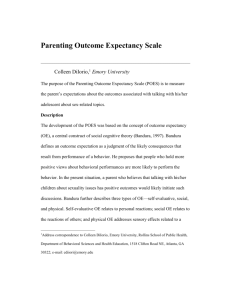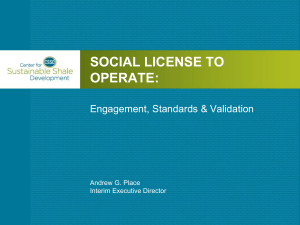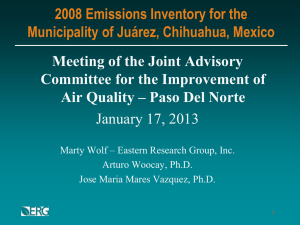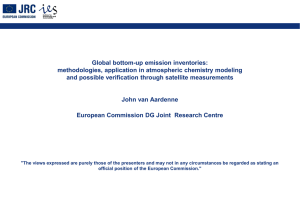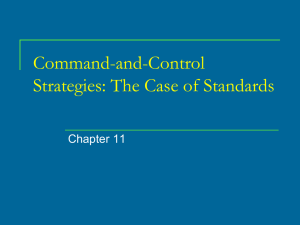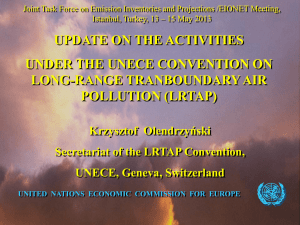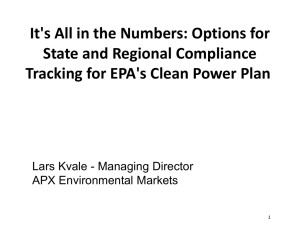Best Practices in reducing air pollution
advertisement
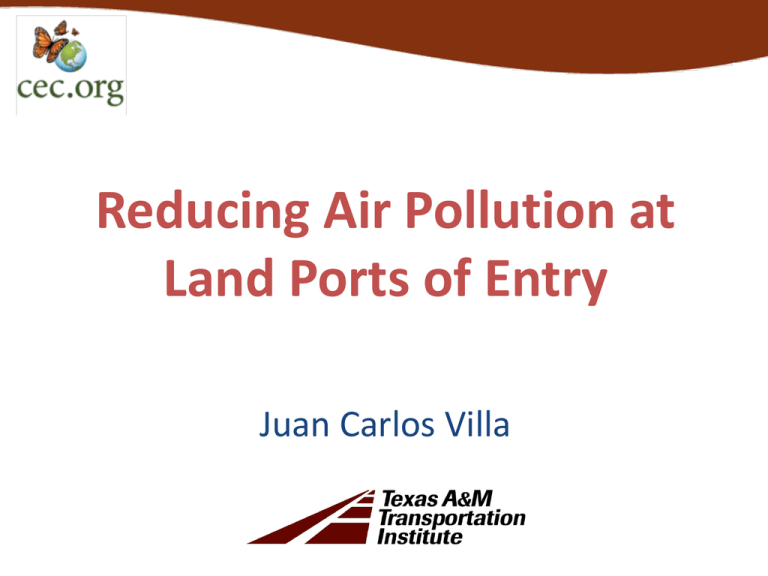
Reducing Air Pollution at Land Ports of Entry Juan Carlos Villa Agenda Objective Data requirements to Estimate Air Quality at Land POEs Strategies to Reduce Air Emissions from Transportation Air Emission Reduction Best Practices at POEs Recommendations for Expanding Best Practices on North American Borders Objective Identify and prioritize best practices implemented in North America and elsewhere to improve air quality, transportation flows and border community and human health Data Requirements to Estimate Air Quality at Land POEs Vehicle emissions measurement is based on two key elements: • Vehicle activity in terms of volume of activity per time or distance, • Emission factors in terms of mass per time or distance Strategies to Reduce Air Emissions from Transportation 1. Fuel Technologies Reduce dependence on highly polluting fossil fuels. 2. Vehicle Technologies Air emissions associated @ POEs can be reduced by: • Reducing the loads (weight, rolling and air resistance, and accessory) • Increasing the efficiency Strategies to Reduce Air Emissions from Transportation 3. System Optimization/Operational Efficiency Operational strategies that change the way vehicles are used. 4. Smart/Sustainable Growth Activity reduction refers to direct or indirect reduction in vehicles miles traveled Strategies to Reduce Air Emissions from Transportation System Optimization/Operational Efficiency • • • • • • • restricting speed improving driving practices optimizing routing to reduce backtracking and empty miles reducing shipment frequency decentralizing supply chain origins improving local distribution systems decreasing non-revenue-producing payload such as excess packaging • increasing the use of longer/heavier trucks and longer trains • increasing the use of double stacked trailers or containers on trains Air Emission Reduction Best Practices at POEs Air Emission Reduction Best Practices at POEs Vehicle Retrofit: Strategies de Reduce Particulate Matter at the Laredo/Nuevo Laredo Border Crossing With funding from the BECC and in coordination with SEMARNAT’s Transporte Limpio program, TTI analyzed various truck retrofit technologies to reduce particulate matter (PM) from drayage trucks at the U.S./Mexico border. San Diego-Tijuana Diesel Emissions Reduction Demonstration Project EPA funded a scoping study to evaluate the costs and effectiveness of emission control retrofit technologies on Mexican heavy-duty diesel vehicles operating in the San Diego County-Tijuana border region DOC: Diesel oxidation catalysts Air Emission Reduction Best Practices at POEs SmartWay and Transporte Limpio SmartWay® Program is public-private initiative, Transporte Limpio is managed by SEMARNAT and the SCT. Washington State and British Columbia Initiatives to Reduce Greenhouse Gas Emissions in the Cascade Gateway, Anti-Idling Program Reducing idling at the border as well as supporting the efforts of other international organizations in reducing congestion and environmental impacts. Air Emission Reduction Best Practices at POEs Port Anti-Idling Program EPA through the SmartWay initiative launched the EModal Port Community System for Drayage. EModal reduces the amount of time trucks spend waiting in queues at terminal gates by establishing terminal appointments Truck Stop Electrification Electrified parking spaces, allows truck drivers to provide power to necessary systems without idling. Air Emission Reduction Best Practices at POEs Border Trusted Traveler Programs CBP’s improved passenger experience, while enhancing security and increasing systemwide efficiencies: Global Entry, NEXUS, SENTRI, FAST Ecodriving According to the UN Environmental Program, ecodriving is a driving style that significantly reduces fuel consumption and thus emissions. The ‘eco’ in ecodriving refers to a driving style that takes into consideration ecological and economic benefits, which significantly reduces fuel consumption and GHG emissions at the same time. Recommendations for Expanding Best Practices on North American Borders • Work with existing North American transportation planning groups (e.g., the US-Mexico Joint Working Committee and the US-Canada Transportation Working Group) to create an information sharing network of best practices at land POEs. • Disseminate and organize seminars of best practices in the three official languages in North America: English, Spanish, and French. • Quantify the contribution of land border air emission reduction initiatives to inform policy. • Disseminate land border crossing data through the network. Thanks, Gracias Juan Carlos Villa Texas A&M Transportation Institute 979-862-3382 Mex. 55-3994-9970 J-villa@tamu.edu
